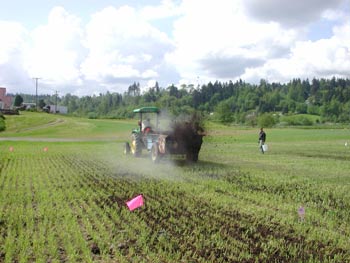Soil Quality
myhreSoil Quality
Soil Quality Project, Carnation, WA.
In 2006 we initiated a project at Full Circle Farm in Carnation, WA to describe how soil texture affects the soil food web. To create a detailed soil texture map and see how this inherent soil parameter affected other parameters we took 81 samples across a 62-acre area of FCF. From each site we analyzed soil texture, bulk density, nitrogen, organic matter, and the soil food web.
Soils within the area of the farm sampled varied greatly in texture. There was a strong gradient of increasing sand and decreasing clay from west to east. Sand ranged from 5-54 % while clay ranged from 9-27%. Four texture classes were identified: sandy loam, loam, silt loam, and silty clay loam.
At the field scale we found that much of the variation in nematode population density could be explained by recent tillage, not soil texture. However, sampling in 2007 was designed to control for management effects so we sampled from one field in a sandier area of the farm and one in a more clay-rich area. The sandier field had more than 8 times the number of nematodes as the clay-rich field. Also, within the sandy field, where clay ranged from 10-17%, clay was strongly negatively correlated with the number of nematodes. On the other hand, in the clay-rich field (16-31% clay) there was no correlation between clay and the number of nematodes.
We conclude that within certain ranges the variation in soil physical and chemical properties can affect biological populations. Thus, careful mapping of inherent soil quality parameters should be the first step in monitoring soil biological populations.
This project was funded by a graduate student research grant from the ♣ Western Sustainable Agriculture Research and Education Program.



















